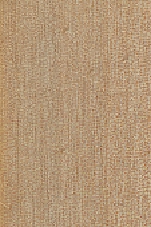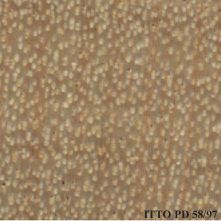
TERENTANG (Campnosperma brevipetiolatum)
Trade Name
Terentang
Scientific Name
Campnosperma brevipetiolatum Volkens
Family
ANACARDIACEAE
Common Names
Campnosperma (Papua New Guinea)
Description Of The Tree
Botanical Description
It is a large tree up to 50 m tall, with boles up to 120 cm in diameter.
Natural Habitat
Terentang is a dominant tree, in peat swamps. In the Solomon Islands it is reported to grow on well drained soils
Natural Distribution
It is fairly widespread distributed, usually in almost clear stands, which are sometimes very large.
Plantations Available?
Reforestation with this species is reported in the Solomon Islands.
Wood Identification
Anatomic Description Of Wood
Wood diffuse porous. Tyloses common. Vessels per mm2 5 to 20. Vessel-ray pits reticulate and/or foraminate. Simple perforation plates. Intervessel pits medium, 7 to 10 micras. Paratracheal axial parenchyma scanty and/or vasicentric. Body ray cells procumbent with mostly 2 to 4 rows of upright and/or square marginal cells (Kribs-II). Septate fibers present. Fibers with simple to minutely bordered pits.
-
 Wood Macro Photo Radial Plane
Wood Macro Photo Radial Plane
-
 Wood Micro Photo Of Transversal Section
Wood Micro Photo Of Transversal Section
Availability
Cites Status
Unrestricted
General Wood Description
Odor
It has no taste and odor.
Color
The sapwood is not clearly differentiated, it usually is light pale yellowish white. The heartwood is light salmon pink when fresh, when dry it is greenish pink to mouse gray darkening to brown.
COLOR INDEX (1=Black, 7=Light yellow,white)
5
Grain
It is mostly straight or interlocked.
Texture
The texture is fine and homogeneous.
Luster
The wood luster is reported to be rather moderate.
Natural Durability
It is non durable, prone to fungi attack if unprotected.
Natural durability index (1= Very high durability, 7=Vey low durability)
5
Resistance To Impregnation
The absorption of preservatives by the heartwood is only fair, the sapwood can be treated well.
Wood Physical Properties
Basic Density or Specific Gravity (O.D. weight/vol. green) (g/cm³)
0.41
Air-dry Density (Weight and volume at 12%MC) (g/cm³)
0.43
Total shrinkage Tangential (Saturated to 0%MC) (%)
9.9
Total shrinkage Radial (Saturated to 0%MC) (%)
3.8
Recommended Dry Kiln Schedule
UK-F; UK-H; US-35-35
Dimensional stability ratio (Total Tangential Shrinkage %/Total Radial Shrinkage %)
2.6
Wood Chemical Properties
Wood Mechanical Properties
Bending Strength (MOR),12%MC (kgf/cm²)
548
Stiffness (MOE) 12%MC (kgf/cm²)
79584
Compression parallel to fiber 12%MC (kgf/cm²)
307
Compression perpendicular to fiber 12%MC (kgf/cm²)
41
Shear strength radial 12%MC (kgf/cm²)
77
Janka hardness (side) 12%MC (kgf)
415
Janka hardness (end grain) 12%MC (kgf)
493
Workability
Sawing
Ingrown stones may cause problems while processing.
Rotary Veneer Cutting
Veneer surface may be hairy or fuzzy. Good, smooth veneer can be obtained with a well-sharpened knife using a bevel angle of 20 degrees.
Sliced Veneer
Veneer surface may be hairy or fuzzy. Good, smooth veneer can be obtained with a well-sharpened knife using a bevel angle of 20 degrees.
Blunting Effect
Dulling of cutting tools is slight.
Machining
It is easy when dry, although woolly structure can prevent obtaining a smooth surface. Suitable clearance and hook angles are required to reduce the incidence of these problems.
Planing
Planing is reported to be easy.
Turning
30
Boring
Boring of this species is reported to be easy.
Nailing
It is easy to nail.
Gluing
It has a good behavior in gluing.
Sanding
Sanding of this wood is rated as fair to difficult.
Finishing
The quality of finishing is rough to woolly.
Coatings
It paints and varnishes well.
REFERENCED USES
End Uses Summary
HOUSING GENERAL, boards, panelling, FURNITURE AND CABINETS, PLYWOOD AND VENEER, cores, TURNING, PACKING, OTHER AND MUSICAL INSTRUMENTS, handicrafts, matches, coffin, moldings
General Housing
- 10 - Silica in Timbers
Boards
- 13 - Dry kiln schedules for commercial woods. Temperate and tropical. Section III. Latin American (Mexico, Central, and South America) Woods–Conventional Temperatures
Paneling
- 18 - W3TROPICOS Missouri Botanical Garden
Furniture Cabinets
- 21 - Tropical timbers of the world. Part III-Southeast Asian and Oceanian Species.
Panels, Veneers
- 25 - Directory of Timber Trade Malaysia
Cores
- 27 - Embassy of Brazil in Japan
Turning
- 30 - Embassy of Honduras in Japan
Packing
- 45 - Recopilación y Análisis de Estudios Tecnológicos de Maderas Peruanas
Handcraft
- 66 - Maderas latinoamericanas. VII. Caracteristicas anatomicas. propiedades fisicomecanicas, de secado, y tratabilidad de la madera juvenil de Cordia alliodora (Ruiz & Pav. Oken.)
Matches
- 71 - Proprietes physiques et mecaniques des bois tropicaux, premier supplement
Coffin
- 78 - Amazonian Timbers for the International Market
Molding
- 79 - Padronização da Nomenclatura Comercial Brasileira das Madeiras Tropicais Amazônicas, Sugestão
Please Provide Information To View Producer Information